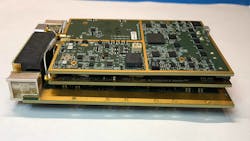SOSA open-systems standard for embedded computing, sensor processing could be in final form by this summer
WASHINGTON – An emerging open-architecture embedded computing standard that offers to enable the U.S. military to specify embedded computing systems that are economical, powerful, upgradable, and competitive, could be finished and ratified by as early as this summer.
The Sensor Open Systems Architecture (SOSA) today is in a preliminary form called snapshot-two. Its third snapshot iteration is expected by the end of this year, and its first official version, SOSA version 1, is expected by mid-2020, says John Bowling, U.S. Air Force Technical Expert for Avionics Architectures and Interoperability.
Bowling made his comments Monday during a SOSA news conference at the Association of the U.S. Army (AUSA) annual meeting in Washington. Bowling is part of the Engineering and Technical Management/Services directorate of the Air Force Life Cycle Management Center (AFLCMC) at Wright-Patterson Air Force Base, Ohio, and chairs the SOSA Business Working Group segment of The Open Group in San Francisco.
SOSA is to be an open-systems industry standard for military and commercial sensor systems to use modular design and widely supported nonproprietary standards for key sensor and embedded computing interfaces.
It will revolve around computer processing and networking for command, control, communications, computers, intelligence, surveillance, and reconnaissance (C4ISR) in a technical and business collaboration that involves such systems as radar, electro-optics, infrared sensors, signals intelligence (SIGINT), electronic warfare (EW), and communications.
The SOSA guidelines are expected to reduce development cycle time and cost; reduce systems integration cost and risk; increase commonality and reuse; reduce sustainment and modernization cost; support capability evolution and mitigate obsolescence; enable technology transition; facilitate interoperability; and isolate the effects of change.
One of the chief aims of SOSA is to narrow-down and focus existing industry standards like OpenVPX to promote interoperability among SOSA-based embedded computing and sensor-processing systems, and create a harmonious ecosystem that benefits the U.S. military forces, prime systems integrators, and embedded computing suppliers.
The SOSA effort seeks to eliminate locking specific vendors into long-term military projects by promoting competition among component suppliers, and thereby help bring down costs and support rapid systems upgrades without expensive and time-consuming requalifications.
"We know what doesn't work -- proprietary designs," says U.S. Army Col. Kevin Finch, project manager for electronic and cyber warfare at Aberdeen Proving Ground, Md., who also made his comments at the SOSA news conference Monday.
Finch says the Army is trying to prevent what he terms vendor-lock, when contracts shut-out competing contractors from systems upgrades and enhancements.
Finch points out that once the SOSA version 1 standard is finished, there will be much more work necessary in the future. "The SOSA standard of today is not the SOSA standard of tomorrow," he told attendees. "The threat will change over time, so we will need to revisit the standard to keep pace with the threats of the future."
Not only will SOSA benefit the military by reducing costs and facilitating quick upgrades, but it also will help embedded computing suppliers by helping them focus their internal research and development efforts.
Open standards help us guide our investment in areas where we ant to innovate," said David Jedynak, chief technology officer of the Curtiss-Wright Corp. Defense Solutions division in Ashburn, Va., who also addressed the news conference.
Last January, Mark Littlefield, defense vertical product manager at embedded computing supplier Kontron America in San Diego said SOSA will yield "an open-systems architecture for defense that works." Littlefield made his comments at the 2019 VITA Embedded Tech Trends (ETT) conference in San Diego.
SOSA will enable military embedded systems designers to create new system, and make substantial upgrades to existing systems, in a fraction of the time that today's open-systems standards allow. "Today this takes months to years, and this could be reduced to weeks to months," Littlefield told ETT attendees.
Related: Open-systems standards like SOSA could promote genuine embedded computing interoperability
Much of today's open-systems military embedded computing systems rely on OpenVPX standards of the VITA open standards, open markets trade association in Oklahoma City. Yet OpenVPX has allowed a proliferation of standards that can cause confusion rather than guidance. In fact, Littlefield calls only a qualified success.
Yet the emerging SOSA standard has the potential to sharpen the OpenVPX standards such that these standards promote true interoperability among third-party suppliers, help prevent vendor lock, and affordable systems development in a relatively short period of time.
Several embedded computing companies have introduced SOSA-aligned products -- among them Abaco Systems in Huntsville, Ala.; Kontron; Pentek Inc. in Upper Saddle River, N.J.; Elma Electronic in Fremont, Calif.; Curtiss-Wright Defense Solutions; Spectranetix Inc. in Sunnyvale, Calif.; and Annapolis Micro Systems Inc. in Annapolis, Md.
The SOSA standards group involves technical experts from the U.S. military services, and has support from top leaders in the Pentagon. A memo signed earlier this year by U.S. secretaries of the Army, Navy, and Air Force, calls for military service acquisition executives and program executive officers to use open-systems standards like SOSA "to the maximum extent possible."
The memo calls out existing and emerging open-systems standards that fall under the umbrella of the so-called Modular Open Systems Approach (MOSA) project, including SOSA; Future Airborne Capability Environment (FACE); Vehicular Integration for C4ISR/EW Interoperability (VICTORY); and Open Mission Systems/Universal Command and Control Interface (OMS/UCI).
"MOSA supporting standards should be included in all requirements, programming, and development activities for future weapon system modification and new-start development programs to the maximum extent possible," stated this memo, signed by Navy Secretary Richard Spencer, Army Secretary Mark Esper, and Air Force Secretary Heather Wilson.
Among the big advantages of SOSA is its reduction of OpenVPX circuit card slot profiles essentially to three -- two basic profiles and a secondary profile for 3U and 6U OpenVPX.
About the Author
John Keller
Editor-in-Chief
John Keller is the Editor-in-Chief, Military & Aerospace Electronics Magazine--provides extensive coverage and analysis of enabling electronics and optoelectronic technologies in military, space and commercial aviation applications. John has been a member of the Military & Aerospace Electronics staff since 1989 and chief editor since 1995.

